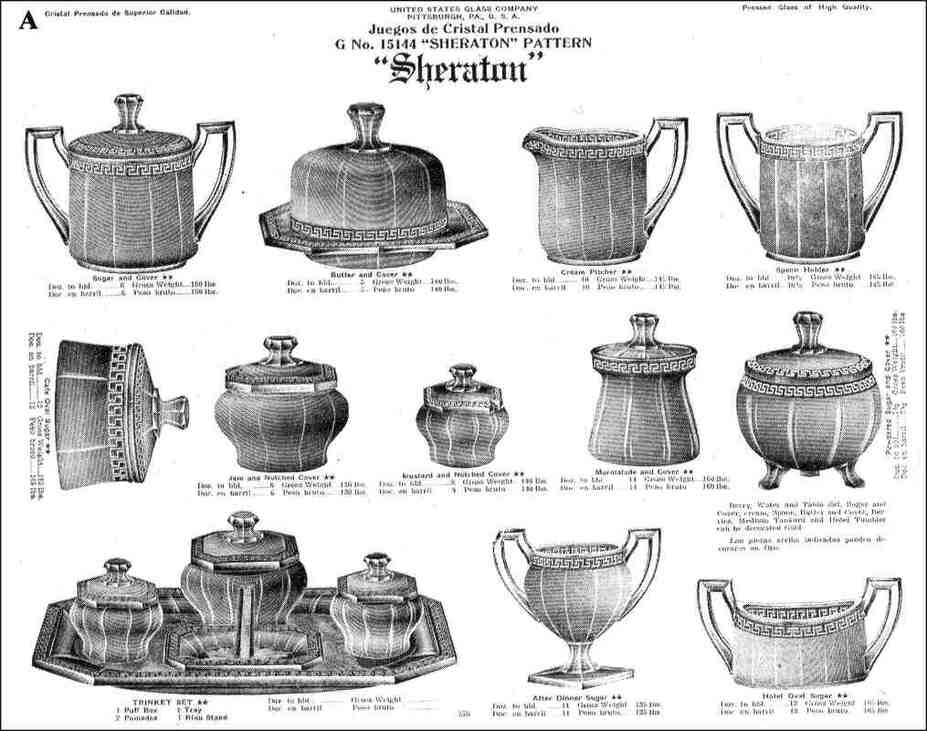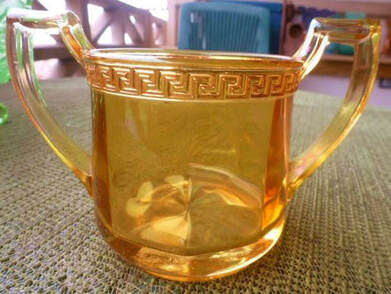The Story Behind The Glass - Sheraton by the United States Glass Company
With thanks to Greg Dilian for his help.
|
Shapes:
Handed sugar
Handled and footed vase, 7 inch Creamer, 5 inch Footed creamer Footed rosebowl, approx 4 inch Tumbler Pitcher |
Colours:
Marigold reported for all shapes.
Pitcher reported in clear iridescent glass with gold trim (March 2020) - see later. |
|
The Story Behind The Glass - Sheraton by the United States Glass Company.
The fascinating sugar (shown above) with its elegant Chippendale style handles and distinctive Greek Key border, was found by Greg Dilian in October 2018. Greg’s researches led him to the catalogues of the United States Glass Company, where he uncovered the fact that this beautiful item was their Sheraton pattern. A wide range of items was illustrated in the 1919 U.S. Glass Company's Export Catalogue in their No. 15144 “Sheraton” Pattern, shown below. The Sheraton items were presented as "Pressed Glass of High Quality". And Greg’s handled sugar is shown on the top row. But stop a moment. The excitement and discovery didn’t end there. Not only is this a most unusual pattern and a previously un-reported shape in Carnival Glass, there was also something else remarkable about this item. It has a moulded U.S. Glass logo on the base! The trademark is a letter U intertwined with a letter S, and it was first used by U.S. Glass around this time: here it is (pictured on the right) on the base of Greg's piece. |
The U. S. Glass logo on the base of the Sheraton sugar. Courtesy Greg Dilian.
|
Extract from the United States Glass Company's 1919 Export Catalogue, as shown in “U.S. Glass from A to Z” by Heacock & Bickenheuser, 1978.
Three other shapes in the Sheraton pattern are known so far, each with a light marigold iridescence – the handled creamer, the small footed rosebowl, and the handled and footed vase. The vase has been found with and without the "greek key" motif border (see below, right).
|
UPDATE from Carl and Eunice Booker. On seeing our NetworK article on this pattern, Carl and Eunice wrote to us about their two pieces of Sheraton: a tumbler and a footed creamer, as shown here. The creamer is a light marigold and has the U. S. Glass mark in the base. The tumbler is lightly iridized, with no mark in the base. The base is thick and has been ground. Both pieces have interior panels. |
Pictures courtesy of Carl and Eunice Booker
|
|
The Early Story
The Sheraton pattern was introduced by U.S. Glass Co., c. late 1912, early 1913. The glass journals reported it widely and enthusiastically – heralding it as a most successful and elegant design. The story begins in July 1912, when renowned designer, Reuben Haley, lodged an application for a patent of a glass vessel, which was granted a few months later (see right) – within a short time it was in production by U.S. Glass, with the name “Sheraton” proudly assigned to it. The 1913 Crockery & Glass Journal had a number of very interesting reports about it: “The new “Sheraton” line of glassware of the United States Glass Co., has proved to be the most popular of the high class lines the company ever created. It is also said that not one buyer who visited the large sample rooms left without placing an order for it. The novelty, variety and artistic conception of the shapes in the new “Sheraton” line of the United States Glass Co., certainly put the ware in a class by itself. The beautiful bold optic effect, finished off with the fine Grecian Key border on the larger pieces, is very fine. The celery, spoon and pickle trays are unique, while the sugars and creams and footed comports are perfect in their outlines. Mr. Haley has excelled himself as a designer. The United States Glass Co., has adopted the plan of placing in each barrel or carton of “Sheraton” ware a large and handsome placard to be used by the dealer in his store advertising. The demand for export is said to be the heaviest the company has ever experienced.” |
Ruben Haley's Patent Application, filed July 22, 1912. and approved on Sept 24, 1912.
|
|
In a fascinating promotion for the pattern, an illustration featuring an entire table laid out with Sheraton pressed glass was shown in the 1913 Crockery & Glass Journal. The accompanying text is worth reading, as it sings the praises of pressed glass generally, which they considered to be “usually regarded as cheap ware fit only for the poorer classes”. It read as follows: “The illustration of a dining table set for four people is to show how tastefully and elegantly a table can be laid with pressed glass – usually regarded as cheap ware fit only for the poorer classes; while as a matter of fact nothing could be more artistic, or appeal more to the aesthetic eye, than the ware used in this picture. True, the newest and one of the most artistic lines has been chosen. Nevertheless, a table set with other Colonial patterns would make just as good a showing as the new “Sheraton” of the United States Glass, which is the one used". It was suggested that "the idea could be used by the managers of glass and crockery departments in stores. The entire cost of the glassware shown in the picture is $1.98. It would sell easily for $3.50.” |
From the 1913 Crockery & Glass Journal - a promotion of Sheraton glassware.
Note that the table and chairs were Sheraton, made of inlaid mahogany. |
Also there were wholesale ads for Sheraton glassware in the Butler Brothers catalogues in 1913 and in 1914.
The range of shapes is huge - a testament to the great popularity of this pattern.
The 1914 ad provides us with the proof that Sheraton was made in true Carnival Glass, not what is erroneously called a "flashed-on" finish! The use of "Iris" was a recognised term used for Carnival at the time, and to remove any lingering doubt, the 1914 ad states the glass had "royal iridescent tints".
|
Above: Butler Brothers, 1914.
A "USG" signed pitcher like the one in the ad was reported by Lance Hilkene in our Carnival Glass Facebook Group (March 2020), and it is pictured below, right. It has a light iridescence with a gold trim on the handle and the greek key pattern on the rim. |
Shown above on the left is an extract from the 1913 Crockery & Glass Journal, explaining that the Sheraton pattern was "Mission Colonial" in style, named after the English Georgian-era designer, Thomas Sheraton. The description is very "up-market" in its appeal, yet as we can see from the Butler Brothers wholesale ads of the time, it was a relatively inexpensive range of glassware - aimed very much at the mass market.
See more Stories Behind The Glass













